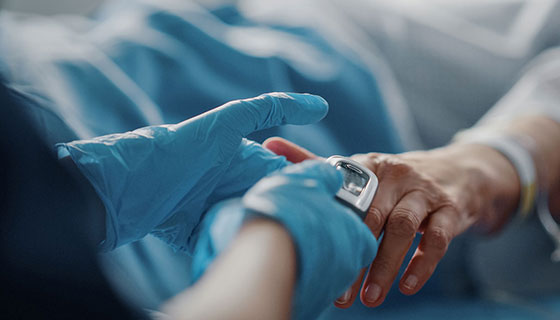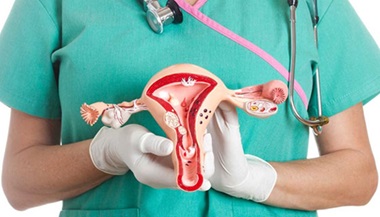Robotic Hysterectomy
What is a robotic hysterectomy?
Hysterectomy is surgery to remove a person's uterus. This surgery can be done through small incisions using a thin, lighted scope with a camera on the end (a laparoscope). This is called a laparoscopic hysterectomy.
In robotic-assisted laparoscopic hysterectomy, the surgeon uses a computer to control the surgical tools. The computer station is in the operating room. The surgeon is able to control the robot's movements steadily and precisely. This lets the surgeon get into tiny spaces more easily. It also gives them a better view of the surgery than with standard laparoscopic surgery. This procedure continues to be researched to improve the technique.
Why might I need a robotic hysterectomy?
Your surgeon may advise this surgery if you have a problem with your uterus that has not responded to other treatments.
Here are some common reasons why a hysterectomy is advised:
-
Noncancerous tumors (fibroids)
-
Cancerous tumors
-
Your uterus has slipped down into your vagina (uterine prolapse)
-
Cells from the lining of your uterus grow outside your uterus (endometriosis). This causes pain and bleeding.
-
Other causes of long-term abnormal uterine bleeding
-
Chronic pelvic pain
Some reasons why robotic-assisted laparoscopic hysterectomy may be advised:
-
You will have smaller incisions than in an open type of hysterectomy.
-
You may have less pain and a shorter hospital stay after surgery.
-
Your recovery may be easier.
-
You may have less risk for complications like bleeding or infection.
What are the risks of a robotic hysterectomy?
Robotic-assisted laparoscopic hysterectomy is a safe procedure. But all surgeries carry some risks. You will need to sign a consent form that explains the risks and benefits of the surgery. You will also want to discuss these risks and benefits with your surgeon. Some possible risks of hysterectomy done by any method include:
-
Reaction to the anesthesia
-
Infection
-
Bleeding
-
Damage to other organs inside the belly (abdomen)
-
Blood clots that form in your legs and may travel to your lungs
An additional risk of robotic surgery:
-
Robotic-assisted laparoscopic surgery may take longer than other types of surgery. This means that you are under anesthesia longer. It may increase some of your surgical risks.
There may be other risks, depending on your specific medical condition. Be sure to discuss any concerns with your healthcare provider before the procedure.
How do I get ready for a robotic hysterectomy?
Sometime before the day of your surgery, you will need a physical exam. You may also need tests to check on your general health. These may include:
-
Blood tests
-
A chest X-ray
-
An electrocardiogram (ECG)
Other points to go over:
-
Tell your surgeon about any medicines you take. This includes prescription and over-the-counter medicines, vitamins, and herbal supplements. You may be told to stop taking aspirin or other medicine that thins your blood and may increase bleeding.
-
Tell your provider if you or someone in your family has any history of reaction to general anesthesia.
-
If you smoke, you may have to stop smoking well before surgery. Smoking can interfere with healing.
-
Follow all directions you are given for not eating and drinking before surgery.
-
Ask your surgeon if you should take your regular medicines with a small sip of water on the morning of the procedure.
What happens during a robotic hysterectomy?
This surgery is often done under general anesthesia. So you will be asleep during surgery. Before the procedure:
-
You will have an IV (intravenous) line started. This is so you can get fluids and medicine to make you relaxed and sleepy.
-
If you are having general anesthesia, medicine may be given through the IV to put you to sleep.
-
A tube may be inserted in your throat to give you anesthesia and help you breathe while you are asleep.
-
You may be given antibiotics before surgery.
-
You may have a catheter placed into your bladder to drain urine.
-
You may have special compression stockings placed on your legs to help prevent blood clots.
Surgery time may range from 3 to 4 hours.
This is what may happen during the surgery:
-
Three or 4 small incisions are made near your belly button.
-
Gas may be pumped into your belly to inflate it. This will give your surgeon a better view and more room to work.
-
The laparoscope is inserted into your belly. Other surgical tools are inserted through the other incisions.
-
Your surgeon attaches the laparoscope and the tools to the robotic arms of the computer.
-
Your surgeon moves to the control area to remotely control the surgery.
-
Your uterus is cut into small pieces to be removed through the small incisions.
-
During laparoscopic-assisted vaginal hysterectomy, your uterus may be taken out through your vagina.
-
Depending on the reasons for your hysterectomy, the whole uterus may be removed or just the part above the cervix. The tubes and ovaries attached to the uterus may also be removed.
-
The incisions are closed with 1 or 2 stitches and covered with small dressings after surgery.
What happens after a robotic hysterectomy?
You will be taken to the recovery room to be watched as you recover from the anesthesia. Most people stay in the hospital for a few days. This is what may happen during your hospital stay:
-
Expect some pain after this procedure. You may be given pain medicine through your IV.
-
Your IV will be removed once you can drink fluids and your bowels are starting to pass gas.
-
You will be given additional pain medicine by mouth or by injection as needed.
-
You can start a normal diet once your IV is removed and you are passing gas.
-
Your bladder catheter will be removed in 1 or 2 days.
-
You may have bleeding from your vagina that needs the use of pads.
-
You will be encouraged to get up and walk as soon as you are able. This helps prevent blood clots from forming in your legs.
-
You may be given medicine that also helps prevent blood clots.
-
Caregivers will help you with your bathroom and wound care.
It’s important to follow all your surgeon's instructions and keep your follow-up appointments once you go home. Take any medicine as directed. Some pain during early recovery is normal. Ask your surgeon what to take for pain.
Here is what you can expect during recovery at home:
-
You should be able to slowly return to your normal diet.
-
Your incision areas should be kept dry for a few days. Follow your surgeon's instructions on bathing and dressing care. You may need to go back to have your stitches removed.
-
Keep walking. You should slowly be able to resume normal activities in a few days.
-
Don't do any heavy lifting for a few weeks. Ask your surgeon when you can return to certain activities.
-
You may continue to have light bleeding from your vagina for several days.
-
You may be instructed not to put anything into your vagina for up to 6 weeks.
-
Full recovery may take anywhere from a few weeks to a few months.
Tell your surgeon about any of the following during recovery:
-
Increasing pain or pain that is not eased by medicine
-
Any drainage, bleeding, redness, or swelling from your incision areas
-
Fever
-
Heavy vaginal bleeding
-
Pain or swelling in your legs
-
Chest pain or shortness of breath
You may have emotional symptoms after this surgery in addition to the physical symptoms of recovery. You will no longer be able to get pregnant and your periods will stop after hysterectomy. Some people feel sad for these losses.
You may notice symptoms of menopause, such as hot flashes and vaginal dryness, if you have had your ovaries removed as part of your surgery. Some people may benefit from hormone therapy after hysterectomy. Discuss this with your healthcare provider.
Next steps
Before you agree to the test or procedure, make sure you know:
-
The name of the test or procedure
-
The reason you are having the test or procedure
-
What results to expect and what they mean
-
The risks and benefits of the test or procedure
-
What the possible side effects or complications are
-
When and where you are to have the test or procedure
-
Who will do the test or procedure and what that person’s qualifications are
-
What would happen if you did not have the test or procedure
-
Any alternative tests or procedures to think about
-
When and how you will get the results
-
Who to call after the test or procedure if you have questions or problems
-
How much you will have to pay for the test or procedure






